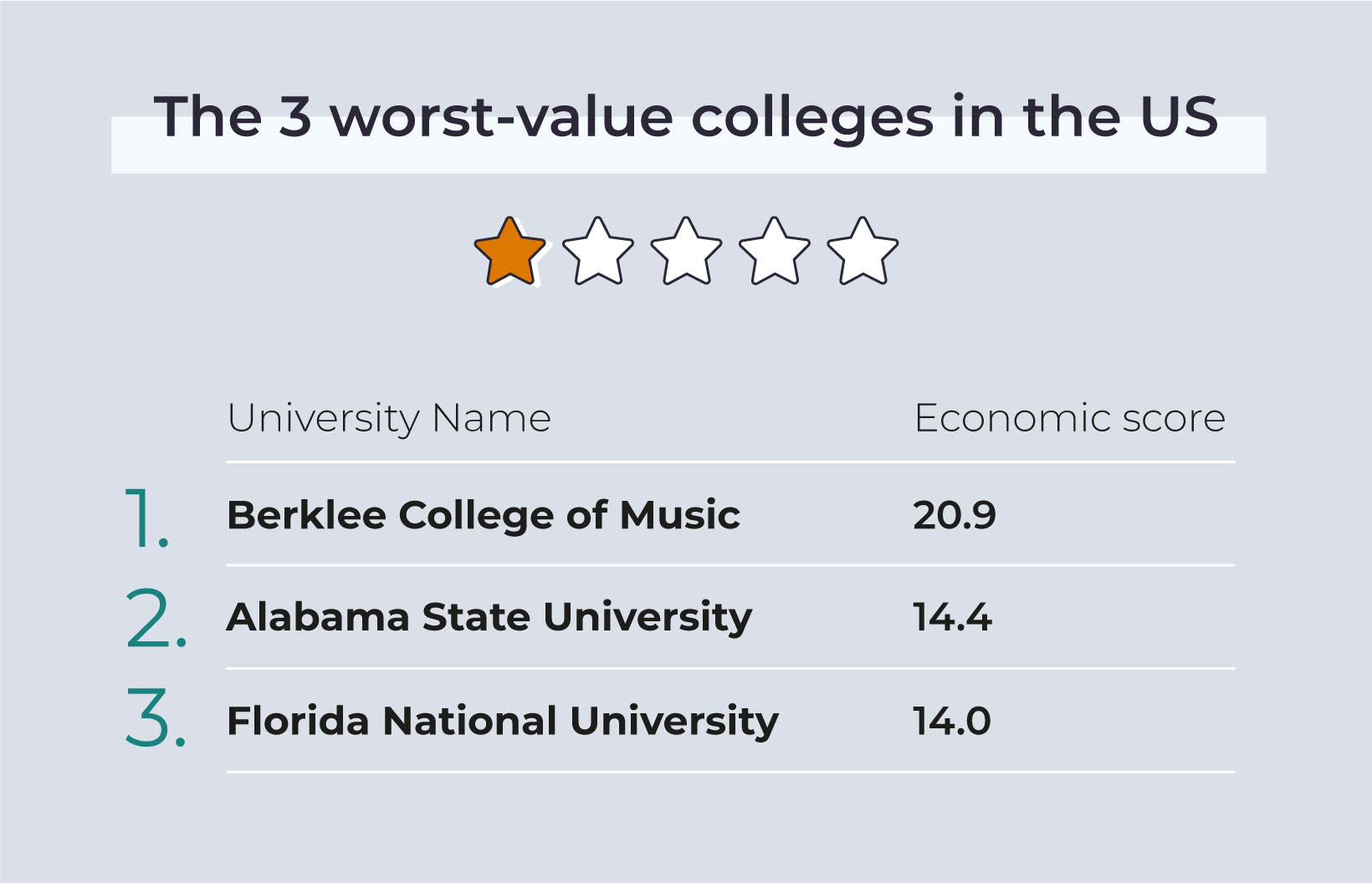In this blog post, we will delve into the world of higher education and The Worst Colleges In The USA then take a closer look at some of the challenges faced by certain colleges in the United States.
- We ranked the worst schools in America using US government data.
- We measured their economic performance and graduation rates to create our list of the worst universities.
- According to our calculations, you might be better off not going to college at all than attending one of these bad colleges.
These Are The Worst Colleges In USA in 2023

University name Economic score
1. Berklee College of Music 20.9
2. Alabama State University 14.4
3. Florida National University 14.0
4. Clark Atlanta University 13.2
5. Herzing University, Madison 12.1
6. Grambling State University 11.9
7. Keiser University, Ft Lauderdale 11.9
8. Academy of Art University 11.8
9. Benedict College 11.1
10. Claflin University 10.3
11. Central State University 10.1
12. New England College 10.1
13. Savannah College of Art and Design 9.7
14. Sullivan University 9.7
15. South Carolina State University 9.6
16. Tuskegee University 9.5
17. Texas Southern University 9.4
18. School of Visual Arts 9.3
19. Bethune-Cookman University 9.0
20. ECPI University 8.8
21. Alcorn State University 8.8
The Criteria for Evaluation
Before we dive into the list of colleges, it is important to understand the criteria used for evaluation. The term “worst” can be subjective, so we will focus on several key factors that contribute to a college’s reputation:
- Graduation rates
- Retention rates
- Student satisfaction
- Post-graduation employment rates
- Accreditation status
The Challenges Faced by Some Colleges
While every college faces its own set of challenges, the following are some common issues that contribute to a college being labeled as one of the “worst” in the United States:
Low Graduation Rates
Graduation rates are an important indicator of a college’s success. Colleges with low graduation rates often struggle to provide the necessary support and resources for their students to succeed academically. Factors such as lack of funding, inadequate faculty support, and a lack of student engagement can all contribute to low graduation rates.
Poor Retention Rates
Retention rates measure the percentage of students who continue their studies at the same institution from one year to the next. Colleges with poor retention rates often struggle to create a supportive and engaging learning environment. Students may feel disconnected or unsupported, leading them to transfer or drop out.
Lack of Student Satisfaction
Student satisfaction is a crucial aspect of any college experience. Colleges that fail to meet the needs and expectations of their students are likely to receive poor ratings in terms of overall satisfaction. Factors such as inadequate facilities, limited extracurricular activities, and a lack of campus community can all contribute to low student satisfaction.
Low Post-Graduation Employment Rates
One of the primary goals of higher education is to prepare students for successful careers. Colleges with low post-graduation employment rates often struggle to provide their students with the necessary skills and connections to enter the workforce. Lack of career services, limited internship opportunities, and a weak alumni network can all contribute to low employment rates.
Accreditation Issues
Accreditation is a crucial aspect of a college’s reputation and quality. Colleges that face accreditation issues may struggle to maintain the necessary standards of education and may be at risk of losing their accreditation altogether. This can have a significant impact on the value of a degree from that institution.
How did a University make this list?
Our economic score factors in cost, earnings after graduation, and payback period to generate one (hopefully) small number. An ideal university offers high earnings after graduation, a short payback period on your educational investment, and low costs, resulting in a low economic score.
When assessing the worst universities, we see a general pattern of low earnings after graduation compared to a high annual cost, which creates a longer payback period.
For example, at our number 1 spot, we have Berklee College of Music, which has an annual net cost of $46,805. The average student takes 4.65 years to graduate, so total costs come to $217,643.25 before any kind of financial aid. Meanwhile, the average bachelor’s level Berklee grad can expect to earn just $34,452 annually.
This university, along with others on our list, offers the delightful combination of high tuition costs and low future earnings, making them a pretty terrible choice of college from an economic perspective.
The Following 21 Schools Are The Worst Colleges In The US based On Graduation Rate.
University name Graduation rate
1. American InterContinental University 19.5%
2. Baker College 23.4%
3. Benedict College 23.9%
4. Colorado Technical University, Colorado Springs 24.2%
5. CUNY Medgar Evers College 24.5%
6. University of Phoenix, Arizona 26.9%
7. Cameron University 26.9%
8. Wayland Baptist University 27.6%
9. Georgia Gwinnett College 27.9%
10. University of Maine at Augusta 28.9%
11. Rogers State University 30.4%
12. Sullivan University 30.6%
13. Albany State University 30.8%
14. Central State University 30.9%
15. Savannah State University 31.2%
16. Kentucky State University 31.3%
17. New England College 31.7%
18. DeVry University, Illinois 32.9%
19. Post University 33.1%
20. Middle Georgia State University 33.1%
21. Herzing University, Madison 33.2%
Conclusion-Worst Colleges In The USA
While it is important to acknowledge that every college has its unique challenges, students and parents must be aware of the potential pitfalls associated with certain institutions. By understanding the factors that contribute to a college’s reputation, students can make more informed decisions about their higher education journey. Remember, it’s not just about the name of the college, but also about finding the right fit for your individual needs and goals.
